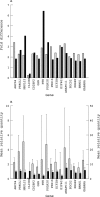Gene expression in peripheral blood mononuclear cells from patients with chronic fatigue syndrome
- PMID: 16049284
- PMCID: PMC1770875
- DOI: 10.1136/jcp.2005.025718
Gene expression in peripheral blood mononuclear cells from patients with chronic fatigue syndrome
Abstract
Background: Chronic fatigue syndrome (CFS) is a multisystem disease, the pathogenesis of which remains undetermined.
Aims: To test the hypothesis that there are reproducible abnormalities of gene expression in patients with CFS compared with normal healthy persons.
Methods: To gain further insight into the pathogenesis of this disease, gene expression was analysed in peripheral blood mononuclear cells from 25 patients with CFS diagnosed according to the Centers for Disease Control criteria and 25 normal blood donors matched for age, sex, and geographical location, using a single colour microarray representing 9522 human genes. After normalisation, average difference values for each gene were compared between test and control groups using a cutoff fold difference of expression > or = 1.5 and a p value of 0.001. Genes showing differential expression were further analysed using Taqman real time polymerase chain reaction (PCR) in fresh samples.
Results: Analysis of microarray data revealed differential expression of 35 genes. Real time PCR confirmed differential expression in the same direction as array results for 16 of these genes, 15 of which were upregulated (ABCD4, PRKCL1, MRPL23, CD2BP2, GSN, NTE, POLR2G, PEX16, EIF2B4, EIF4G1, ANAPC11, PDCD2, KHSRP, BRMS1, and GABARAPL1) and one of which was downregulated (IL-10RA). This profile suggests T cell activation and perturbation of neuronal and mitochondrial function. Upregulation of neuropathy target esterase and eukaryotic translation initiation factor 4G1 may suggest links with organophosphate exposure and virus infection, respectively.
Conclusion: These results suggest that patients with CFS have reproducible alterations in gene regulation.
Figures


References
-
- A report of the CFS/ME working group. London: Department of Health, January 2002. (http://www.doh.gov.uk).
-
- Fukuda K, Straus SE, Hickie I, et al. The chronic fatigue syndrome: a comprehensive approach to its definition and study. Ann Intern Med 1994;121:953–9. - PubMed
-
- Komaroff AL, Buchwald D. Chronic fatigue syndrome; an update. Annu Rev Med 1998;49:1–13. - PubMed
-
- Powell R, Ren J, Lewith G, et al. Identification of novel expressed sequences, upregulated in the leucocytes of chronic fatigue syndrome patients. Clin Exp Allergy 2003;33:1450–6. - PubMed
Publication types
MeSH terms
Grants and funding
LinkOut - more resources
Full Text Sources
Other Literature Sources
Medical
Research Materials
Miscellaneous
